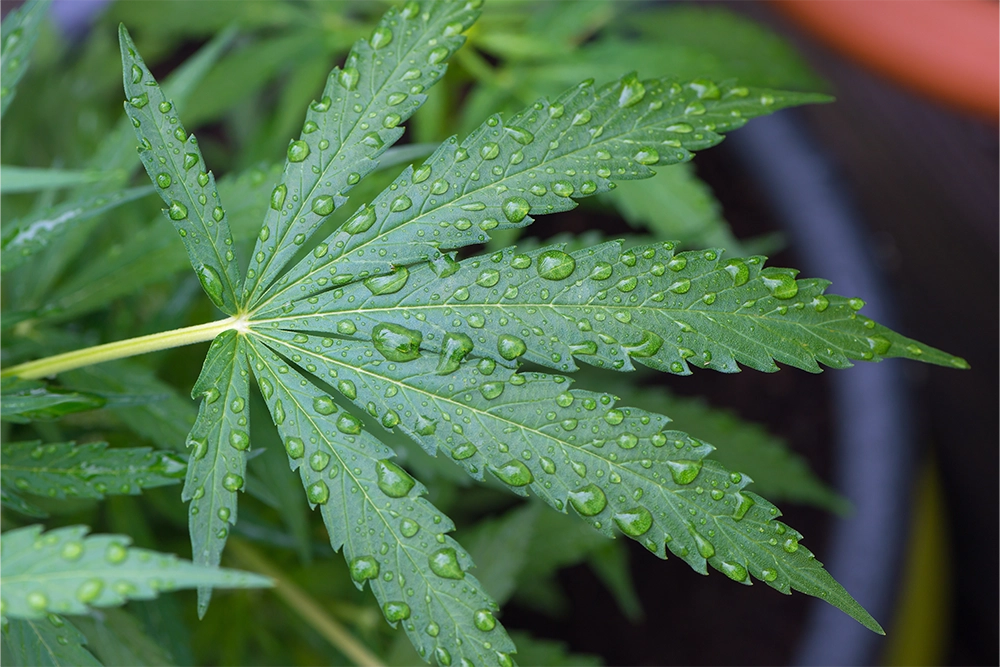
How to Water Your Cannabis Plants
Share
The most common challenge encountered by home gardeners is watering. Whether it’s overwatering or underwatering, finding the right amount of water can be tricky. Several factors affect how you water your plants, such as the soil, weather, watering method, and plant size.
How much water does a cannabis plant need?
Watering your cannabis plants fluctuates based on several factors such as the stage of growth, growing medium, and environmental conditions. For optimal cannabis cultivation, your growing medium should maintain a balance with around 50% water and 50% oxygen.
So, how much water do plants need daily? Enough to maintain a moist but not dripping medium.
External factors that affect your weed watering schedule
Different environments require varying approaches to watering weed. Recognizing the needs associated with various setups is crucial for developing an effective watering schedule.
Outdoor: Outdoor growing environments necessitate a keen eye on the weather. When temperatures rise, plants will need more frequent watering to stay hydrated. If you use an automated irrigation, set to water between 4-6 AM to reduce water loss through evaporation. You also can cover the soil with mulch.
The bigger the plant grows, the more water you will need to provide. Adjust accordingly with the growth of your plant. You will need more water during the flowering stage of growth than the early vegetative stage.
In the Ground: Growing directly in the ground allows plants to develop expansive root systems, accessing a more substantial water supply from the soil. This environment generally demands less frequent watering, but it’s vital to ensure the soil retains sufficient moisture at deeper levels to nurture the root system.
In Containers: Container-grown plants have limited soil volume, which means they can dry out much faster. It is crucial to monitor the soil moisture regularly to avoid underwatering. Small plants require water to reach at least the depth of their roots, promoting healthy growth and preventing the onset of root rot.
Indoors: The frequency of watering for growing weed indoors will largely depend on the size of the container you’re using; larger containers will retain moisture for a longer period, requiring less frequent watering, while smaller containers might need to be watered more often.
It’s crucial to tailor your watering schedule to suit the specific needs of your indoor setup. Make sure you keep a close eye on the growing medium’s moisture levels to ensure optimal growth. Different mediums will have different watering requirements.
Soil:
- Watering Frequency: Generally, requires less frequent watering compared to other mediums as it retains moisture well.
- Tips: Maintaining consistent moisture ensures your biological activity remains high ensuring nutrient cycling and plant availability.
Coco Coir:
- Watering Frequency: Requires more frequent watering, sometimes daily, because it doesn’t retain water as the soil does.
- Tips: Do not allow coco to dry out; it becomes incredibly hydrophobic and water will run off the sides instead of penetrating the medium.
Rock Wool:
- Watering Frequency: Needs consistent monitoring as it can retain a lot of water, thus risking root rot, but can also dry out quickly.
- Tips: Properly soaking rock wool before use is essential, and it is advisable to maintain a slightly acidic pH to facilitate optimal nutrient uptake.
Temperature and Humidity: Both high temperatures and low humidity levels can cause plants to lose water more quickly. During hot and dry periods, increase your watering frequency to prevent the soil from drying out. In contrast, cooler temperatures and higher humidity levels will decrease the plant’s water uptake, thus reducing the need for frequent watering.
How to know if you’re overwatering vs underwatering cannabis
It can sometimes be a challenge to identify whether your cannabis plants are suffering from overwatering or underwatering, as the symptoms often appear quite similar. Both situations can result in drooping, wilted leaves, and a lack of turgor, which refers to the firmness of the plant tissues.
To determine whether your plant has been overwatered or underwatered simply feel the soil about two inches deep. If it feels soggy, you are overwatering, while dry and crumbly soil indicates underwatering.
If your plant is suffering from overwatering your soil will be wet and may be caused by lack of drainage. Make sure your soil has lots of aeration including rice hulls and pumice. If you are growing in a container, make sure there are drainage holes on the bottom, or try growing in a fabric pot.
Overwatering can lead to fungal pathogens like root rot and should be avoided at all costs. It is better to under-water your plants than to overwater your plants. You can always give your plants more water, but you can’t give them less, and treating fungal pathogens can be detrimental to your plant’s health and ultimately impact yield and quality.
Both overwatering and underwatering can cause nutrient lock-out, preventing the plant from absorbing essential nutrients. Maintain optimal watering habits to ensure this doesn’t happen and keep your medium moist but not dripping.
When is the best time to water your plants?
Cannabis plants, like us, may need water at different times each day. But a general rule of thumb is to provide consistent watering in the early morning to provide your plants with water as soon as they begin photosynthesizing. This also helps prevent water loss to evaporation.
If it is a hot day you can provide them with water throughout the day. This is very important if they are in small containers that can’t hold a lot of water. Pay attention to your plants and avoid watering cannabis in the evening to prevent fungal pathogens.
The proper method for water marijuana
Proper watering is crucial for successful marijuana cultivation, and choosing the right irrigation method can be a game-changer. Many growers opt for irrigation systems like Blumats drip irrigation or Rain Bird soaker hoses, which offer an automated and consistent water supply to your plants, ensuring they receive the optimal amount of moisture. These systems can be set to deliver water slowly, allowing for deep penetration into the soil, and fostering healthy and extensive root development.
Hand watering with a shower setting on your watering device is another excellent method, particularly for smaller grows, ensuring a gentle and even distribution of water without causing soil erosion.
To ensure deep soil hydration and minimize runoff, employ a cycle of watering multiple times, allowing the water to penetrate before watering again, repeating up to four times per container. This tactic encourages the roots to grow deeper, securing a strong foundation for your plants and enhancing their ability to absorb nutrients, paving the way for a lush and vibrant cannabis garden.
How pH and nutrients impact watering
Looking after your cannabis plants involves not just watering them, but also ensuring that the water has the correct pH level. This pH level plays a significant role in helping the plants absorb the nutrients required to grow cannabis well.
Maintaining the pH level of your water between 6.0 and 6.5 is generally ideal because it allows for the best absorption of nutrients. This slightly acidic environment is where nutrients can be absorbed, promoting healthy growth at various stages. This is important to consider when growing with water-soluble nutrients, especially in mediums other than soil.
When growing in soil, your water’s pH is not as important as your soil’s pH because the soil acts as a buffer.
When growing in a soilless medium your plants rely on nutrients that are available for your plants. These nutrients are typically provided in slow-release fertilizer within the media or watered in with water-soluble nutrients.
Water and nutrients must be applied at a specific pH to avoid nutrient lock-out. It is also important to consider that certain nutrients are mobile in water and therefore having consistent water in your medium is important. When your soil is dry these nutrients are not available.
At the same time these same water-mobile nutrients like nitrogen are easily washed out of your media and therefore having runoff is not ideal as you are throwing away any water-mobile nutrients with that runoff.
The type of water you use can also affect the availability of nutrients. Tap water contains chlorine which can hurt your plant’s growth. You can add humic acid to immediately tie up the chlorine or allow your tap water to sit out for 24 hours after gassing the chlorine prior to use.
Conclusion
Watering your cannabis plants is more than simply pouring water into the soil. Things like growth stage, soil, and surroundings are important in deciding when to water your plants. By paying attention to these variables, you can ensure that your cannabis plants grow to their full potential.

